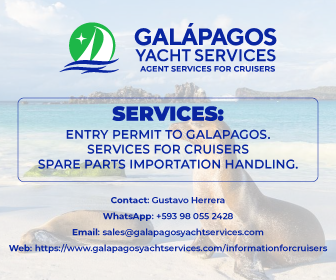Galapagos: Enchanting Islands and Intriguing Sea Lions
Despite the costs, bureaucracy and restrictions – the Galapagos Islands are the ideal stopover en-route from Panama to French Polynesia and should be on every Pacific cruisers’ bucket list, says Richard Freeborn of SV Hawkeye. Read his extremely detailed report from his January 2024 visit, to assist with planning, navigation, island information, the paperwork and the incredible activities these enchanting islands offer.
Published 1 year ago
We would like to heavily caveat everything that is written below; this is just our experience. None of this advice should in any way replace what your agent tells you. Please, if your agent gives you advice, then take it, and don’t quote anything that we say!
Before leaving mainland Central America
Well before leaving the mainland you’ll already, hopefully, have been in contact with your Galapagos Agent which in our case was Javier from Yacht Agents Galapagos [javier@yachtagentsgalapagos.com] who has been superb.
Stick to everything they say and take ALL their advice! Read everything they send you and do your best to comply with all their requests and requirements.
Here are some of the notices that we posted showing our arrangements for garbage:


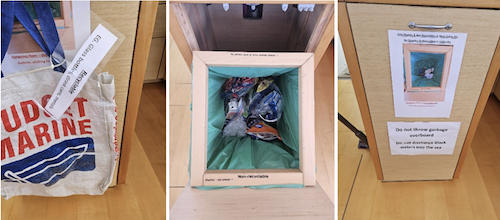

Besides the usual clearance documents, before leaving Costa Rica we had to have a Hull Inspection Certificate by a local diver and Hawkeye had to be fumigated and a Certificate issued.
Before fumigation all fresh food and cutlery had to be removed and air conditioning turned off. From the outside looking in through the windows, poor Hawkeye’s interior was a complete wall of white mist! Our eleven smoke alarms were most unhappy. We sat in a bar for three hours to wait for the fumes to die down before going on board and ventilating.


When arriving in Galapagos pay careful attention to the latest requirements for what food you can have on board, which now includes no fresh eggs.
Money
Bring plenty of cash! Many places in Galapagos don’t accept credit cards, only $USD. This is the case for diesel fuel (see notes below) and excursions in particular. Many places in Santa Cruz take cards, less so in San Cristobal but very few places in Isabella.
Floreana doesn’t have a credit card machine on the island. There are ATMs on all three islands, except Floreana, which generally give out a maximum of $200 USD, with a 4.5% charge, and, with the better ones, you can have up to three withdrawals per card per day.
Internet access
There is reasonable cell coverage in Santa Cruz, Cristobal and Isabella. We used Airalo.com with an eSIM, which was very slow but mostly reliable. Notably there is zero cell coverage in Floreana as many years ago the residents there voted not to have phones.
Floreana, which is really just a small village, does have a number of Starlink systems that don’t need passwords. Starlink works throughout the Galapagos, where it is officially available, but we found the speed to be relatively slow, perhaps 5 to 30 MBPS whereas usually it is more like 200 MBPS which is because there are so many Starlink dishes active.
Voyage to Galapagos
You can see the track of our voyage track here:
Having transited the Panama Canal on 10th December 2023, we left Golfito in Costa Rica on Tuesday 9th January 2024 and arrived into Puerto Ayora on Santa Cruz at 1pm on Sunday 14th January 2024.
This is a similar voyage to coming from Panama City and the Perlas Islands. The promised SW trade winds blew too much from the SSW, directly from Galapagos, so we ended up motoring into head seas, currents and winds more than we wanted.
First day was great sailing, second and third were horrid, then the trades kicked in for the fourth, fifth and sixth days, although we still kept one engine on at low speed (partly because we are softies and need the electricity generated by the engines to have the aircon running 24/7 in three cabins!) so that we were making 7 to 8 knots in around 7 to 12 knots of true wind. There was no sign of the Panama current setting in to help our voyage.
Bear in mind that, as such, when you get within perhaps 100 to 150 miles of Galapagos, the trade winds blow directly from Galapagos towards Panama City! The best advice is therefore not to head directly for Galapagos from Panama City. Instead head due South and do a graceful, slow curve to your right, the SW or SSW, which then brings the winds on to your port side as you approach Galapagos.
About 60 miles from Galapagos you sail over the equator, so watch out for King Neptune arriving to hold court; see King Neptune’s Court Proceedings document and the sample certificate in the Appendix.
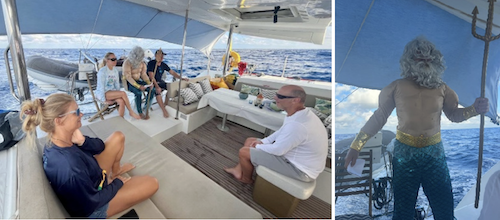

Javier (our agent) wanted to be kept updated with our ETA as he has to line up ALOT of officials from different departments. He wanted us to be inspected and cleared as soon as possible, which suited us!
SANTA CRUZ ISLAND
Arrival at Puerto Ayora
The first port can now be either Puerto Baquerizo Moreno (San Cristóbal), Puerto Ayora (Santa Cruz) or Puerto Villamil (Isabela), depending on where your agent wants you to go. Up until 2023 it was only possible to clear in at San Cristobal, which is what all sailors have always told us to head for in the past. As Javier is based in Puerto Ayora on Santa Cruz island this is where we headed. This anchorage is the only one of the four available to yachts in Galapagos.
Puerto Ayora is completely open to the trade winds and waves. The swell is variable. Some of the time it’s not more than about 0.5m swell but it can be one metre and very rolly. We are a catamaran and generally headed straight into it, so it was bearable. It could be quite rolly for a monohull when the wind doesn’t quite line up with the swell from time to time or the wind goes really light.
Although we were told that you could anchor a small yacht on the other side of the harbour where there is slightly more protection from the swells, in practice this is impossible as there is no longer any room left over there because of the sheer number of local boats.
There were two lat/longs provided by our agent to anchor which are shown as anchor symbols on our chart plotter, below. In practice these are taken up by up to a dozen 30m plus Galapagos-based mini cruise ships, so we anchored further in as shown on our chart plotter:


Holding in pure white fine sand is excellent once the anchor digs in. We are the left of the two catamarans in the photo below, which is taken from the town quay.
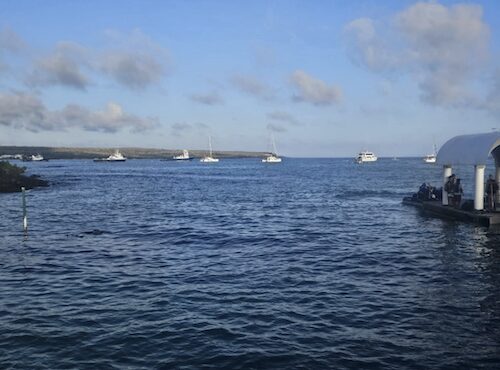

After this photo was taken, many more large mini-cruise vessels anchored ahead of us.
We didn’t see any point in laying a stern anchor, not least because they can end up with their line being fouled by water taxis and, anyway, none is required in this part of the harbour. Without exception, all the large vessels just to windward of us are anchored without any stern anchors. There are three commercial vessels near us that are anchored, but have laid stern moorings. They didn’t trouble us. But there may be times when a stern anchor is beneficial.
Formalities and Inspection
Put all your fenders down on your starboard side (as this is most likely to face the town dock) and only board through your starboard boarding gate. Don’t try and board at your stern as the 30’ long water taxi (and imagine the weight with all those people on board!) will simply smash up your stern. We also put two ropes out by the boarding gate so that when the ferry arrives they pull themselves alongside using those ropes rather than trying to pull on our stanchions or fenders. You need to put these fenders out the moment you are anchored in case a boat with officials turns up!
The day before we arrived we made contact with Javier (Whatsapp +593 98 722 9577) on a Whatsapp group with his colleague with Danny Buenaño (Whatsapp +593 99 194 3827) which made things easier. We anchored at 1pm on Sunday, had a quick glass of bubbly, then two hours later we had 14 officials arrive on board Hawkeye! Danny, who is Javier’s colleague, came aboard with the officials.
The officials were all very courteous and polite although the police and Armada (i.e. Navy) wore heavy black boots, some of which did leave dirt on our decks. Even though it was a Sunday, we paid no overtime fees. We had a large jug of water and glasses for the officials, who settled themselves down on our aft deck. We also handed out sodas although beers were initially refused. The inspection took just over an hour.
They were very interested to see our oil spill kit, which was essentially a plastic shopping bag with “Oil Spill Kit” hand-written on. It had a pile of nappies in it and a large amount of clean white rags that we bought from the chandlers in Panama.
They inspected our galley fridge, but didn’t look in our outside deep freezer, perhaps, with hindsight, because we forgot to point it out to them! They wanted to inspect one life jacket and asked about the man overboard equipment and liferaft, which we pointed to, but they didn’t inspect them. They asked questions about our holding tanks and inspected the valves and their accompanying notices; this was clearly a key point for them to inspect.
There is a long form to fill in for immigration for each passport, which takes a little while. There was no interest in any of our cleaning materials. Looking in the local supermarket, the products on sale are no different to those on the American mainland, so we needn’t have worried about trying to find extra-special eco-friendly products although it would be best to find these if possible.
The police and Armada both did an inspection of the inside of Hawkeye including opening some cupboards. The Armada also inspected one engine room, from above, but not the other. No one looked into any bilges or our generator compartment or bow storage cabins etc.
There were lots and lots of questions about all sorts of things, but mostly the officials seemed to just be ticking off their check lists.
Overall the total cost for our crew of six was about US$3300.
Danny managed to field most of the questions in Spanish which made it a lot easier; the officials were sometimes hard to understand as they speak a local dialect. Danny had all the paperwork printed out for each set of officials, so that made things really easy too.
Danny and Javier had done a first-class job for us, so we were delighted with their service. It also seems that the officials trust Danny and Javier to vouch for us that all was well with Hawkeye and we are no threat to the Galapagos.
The officials eventually left, most clutching a cold beer, seemingly happy and mostly smiling, apart from one poor guy who was badly seasick and had been sick over the side. Danny stayed behind and kindly answered a multitude of question about places to go, things to see etc. Danny and Javier have been very helpful and continued to answer our questions on Whatsapp.
Later on, by Whatsapp, Javier said that the officials wanted photos of our “fuel dispersant liquid”. We sent them photos of our degreaser, but this wasn’t really what they were looking for. I looked in the ferrateria/chandlers, but they had nothing and there was nothing in the supermarket; in the end they didn’t ask us to buy anything.
Puerto Ayora
Santa Cruz island has a population of about 12,000 which is larger than the “capital” island of San Cristobal. Part of the reason for this is that there is an airport on Baltra Island, built by the USA in WWII, which is linked to Santa Cruz by ferry which is where most of the passengers on the mini cruise ships arrive.
A key point is that the airport in San Cristobal is a better place to leave/join because it’s a 10 minute taxi ride from the airport. To get to the airport in Baltra you have to take a taxi across the whole of Santa Cruz, then take a ferry and a bus to the airport, so that’s a lot more time and hassle.
Unlike San Cristobal, the colony of sea lions in Puerto Ayora is smaller so there is less likelihood of your yacht being boarded by them, but they will still board if you have no defences. We were boarded by a sea lion whilst we were out for the day, despite putting fenders up at the stern and closing our stern boarding lines.
There was a bad mess which we cleaned up immediately before it baked on in the sun. Even though the sea lion was only on board for perhaps an hour or so, we haven’t yet managed to get the stains out of the GRP. Most of the boats here have something across their transoms to stop them boarding so we have now beefed up our sea lion defences! We bought some material from the local ferrateria and stretched it across our transoms.


You can only use your dinghy to go to and from the town dock; any other use is illegal and the Armada will be notified. There are no beaches in Puerto Ayora to leave a dinghy on. You aren’t allowed to leave dinghies on the town dock but even if you did, you would end up with a sea lion on board it. Do bear in mind that it is illegal to go within two meters of any animals in Galapagos, so once the sea lion is in your dinghy you have to wait until it decides it doesn’t want to be there anymore. They destroy dinghies!
Hence why our dinghy remained in its davits. However, the water taxis are excellent, at $1 per person each way; make sure you have plenty of small denomination notes! They come quickly when called on VHF Channel 14. To be honest, its quicker and easier using a water taxi than our own dinghy. Bear in mind that although the currency is $USD, the $1 coin is Ecuadorian.
A boat comes around in the morning to collect garbage at $3 a bag. We had ours split into three, as instructed – organic, non- organic (ie tin cans, bottles etc) and non-recyclable, in different coloured bags. The guy on the boat then told us to put the whole lot in one bag as it would be sorted out onshore. Fine, that saved us $6! We are still wondering why they made such a fuss about splitting the garbage only to find that it wasn’t necessary? However, if you don’t have the garbage separated then you will fail not just the initial inspection when you first arrive, but also any subsequent inspections, especially when you move to a different port so we kept that regime in place, just in case.
There is an excellent combined Ferreteria /Chandlery about a 10 minute walk from the quay. This is not the same as the Ferreteria that is on the quay. This was well equipped with everything from new Yamaha outboards to refrigerant as well as tools and oils; it was better than many of the chandlers we saw in Costa Rica, Columbia or Panama, which is certainly not what we had expected. There are clearly lots of boats with engines so there will be mechanics that your agent should be able to advise you upon.
There is a supermarket on the quay which is quite well stocked. On Saturday there is an excellent fresh food market in town – about a 20 minute walk or $2 taxi ride.


Touristy things to do in Puerto Ayora
Puerto Ayora is actually quite a sweet town with good restaurants, brick paved roads (“Follow The Yellowbrick Road”!), lots of bars, souvenir and jewellery shops with a small but quite good supermarket on the quay.
Taxis are right by the quay where the water taxi drops you off and are relatively inexpensive. The Tortuga beach is worth a visit although we found the water cloudy and little wildlife but it is a lovely sandy beach. No alcohol, smoking or music is allowed and the wardens start closing the beach at 4.30. There were a few baby hammerhead sharks which are about one metre long swimming right off the beach as well as marine iguanas. We made the mistake of taking a land taxi, not realising that the taxi gets nowhere near the beach! When you get out of the taxi there is a one hour, very hot walk to get to Tortuga Beach.
You can’t swim at the first beach because of rip currents so it’s another 20 minutes to Tortuga Beach. The smart money is on taking the water taxi ($20 per person return) from the pier in Puerto Ayora. It goes four times a day, last one at 4.45pm, but best to book the day before from the kiosks by the pier.
It’s a 15 minute walk from the pier to the Charles Darwin Research Station. When you arrive at the entrance, its best to pay the $10 per person so that you can see the tortoises which includes a very good guided tour. Everywhere interesting you go in Galapagos requires you to have a guide, so if you don’t pay then you don’t see! All the guides we had were first-class and well worth the cost.
After the tortoises you can then visit the Charles Darwin Centre free, where there is a small café. It’s a 25 minute taxi ride to the big inland tortoise sanctuary, where you can see the giant tortoises in the wild, and the spectacular underground lava tunnel walk, for which we paid $50 per cab which took 4 people, return.
Exploring the Galapagos Further
Javier arranged for Hawkeye to be cleared to sail into four islands, which is the most allowed, as shown below. To visit more/different islands you need to take a cruise ship. All cruise ships in Galapagos are based in Galapagos, so they are all relatively small.
Puerto Ayora is the starting point for many of the tours in the Galapagos, so this appears to be the best place to base your yacht if you are going on a cruise ship tour. It’s also where many flights arrive on the sister island of Baltra to the North which is connected by a ferry.
However, given that this anchorage is open to the trade winds and swell, it may be that monohulls who may find it rolly would be better off in any of the other three anchorages, which are all much more sheltered from the trade winds.
To move port, your agent must request your Zarpe from the Port Captain at least 24 hours in advance. The Zarpe from San Cristobal or Isabela will also cover Floreana. Arriving in the next port may mean that you are re-inspected, which we were told can include a hull inspection but all we generally had was a visit from the Armada who didn’t inspect anything much.
Most yachts navigate the four islands in an anti-clockwise direction which is Option 1 on the map below. We did this because we wanted to get away from the busy port of Puerto Ayora in Santa Cruz; Isabela was SO quiet and SO calm in comparison!


Option 2 – Clockwise


ISABELLA ISLAND
Go through port and starboard buoys that are on Navionics chart (when you zoom in far enough!) and are in place. Yellow buoy near entrance is not in place. Much deeper water (4m to 6m) in port than Navionics (0.5m) suggests. We never had less than 3 metres of water at the very lowest tide, so most monohulls can get into the shelter, away from the rolling. There is a bit more water further out from where we anchored, perhaps 4m at the lowest tide, but still well inside the protection of the reefs. Once here you realise how rolly it is in Santa Cruz! It’s very calm indeed behind the reefs. There is room for maybe about 20 yachts to anchor.
Our track is in purple (zoomed out so the red and green buoys near the entrance aren’t shown) on the following screenshot from our chart plotter:


Anchoring is in sand with good holding. Fenders best out on the port side as that faces where the water taxi comes from. Javier’s local agent Manuel (Whatsapp +593 99 776 3091) bought someone from the Armada on board to check our Zarpe. He didn’t inspect anything and left in the water taxi, leaving us with Manuel who, throughout our stay, has been incredibly helpful and attentive.
The water taxi here is $2 – so as we are six aboard that makes it $24 to go ashore and back, which is expensive! You can use your dinghy, but it’s not recommended (or really possible) to leave the dinghy on the dock due to the sea lions and other local boats coming and going.
If you do take your dinghy just to drop people in/out then DON’T go straight across the anchorage as its full of rocks! Instead go the same way as the local boats, which is right around the outside, through the mooring trots, as shown in our track in yellow below.


There is a $10 per person tourist tax which you pay when you first go on the dock, if the staff are there, or catch them next time.
There is no fuel for yachts here. Take your own garbage and put it in the bin, which is about 100m up the dock, off to the left near the toilets. It’s a 10-minute walk into town from dock. There is one pair of ATMs in town but they didn’t work for us. Plenty of restaurants and bars and a small supermarket. Roads in town are made of sand but the longer roads on the island are tarmac.
We took three tours, all arranged by Javier’s local agent, Manuel +593 99 776 3091 whose family owns various tourist businesses so he is well connected:
- Snorkelling at the Lava Tunnels. A 40-minute boat trip to go 15 miles then two different snorkel locations. Saw black and white tipped reef sharks, plenty of turtles, sea lions and seahorses etc. Our guide was excellent. $135 each. Watch a short video of our trip here: Galapagos Snorkelling
- Horse riding to Sierra Negra Volcano. ¾ hour taxi ride then about 45 minutes up the volcano on the horses. Then it’s a good 1 ½ hike there and back for which walking shoes are required. Lunch on the side of the volcano with an amazing view. Then back on the horses and taxi. Our guide was excellent. $130 each. Watch a short video of our horse-riding experience here.
- Snorkelling at Tintoreras. This is the lava islands right next to the anchorage, but you aren’t allowed to go there in your dinghy or to swim there. The guide was excellent and included a walking tour, so it was very good value. About $50 each.
- We also hired bikes in town to go to the Wall Of Tears, built by prisoners.
FLOREANA ISLAND
This is even more relaxed than Isabella! Anchoring is easy, just off the Black Beach near the jetty, in about 6 metres in sand with excellent holding. It appears at first to be a slightly bleak and desolate place, but the people were lovely and welcoming which made all the difference. With only perhaps just over 100 people on the island, we probably met quite a lot of them! The island is surprisingly well equipped; there is even a hospital here with four staff – doctor, dentist, nurse and ancillary.
We only stayed two days. The anchorage is relatively calm as you will be tucked in against the trade wind driven seas.
Javier’s local agent, Max, who also answers to Johnni (Whatsapp +593 96 705 9117) was just awesome. He’s everything in just one guy – farmer, fisherman, tour guide, naturalist, restauranteur, agent etc. He was the mayor for a decade and the current mayor is Max’s wife!
His cousin Peter drives a water taxi which is $1 each way, so no need to use the dinghy. We put our fenders out on the port side as that’s the side facing the island. However, there is actually a dock where you could put your dinghy if you like, they are relaxed here about such things, albeit we could see plenty of sea lions on it so we didn’t want our dinghy wrecked to try to save a few dollars. Max came aboard, took a photo of our Zarpe then sent a stamped copy back by Whatsapp.
We paid Max $56 each for a tour up into the hills to see the tortoises and the Pirate caves where they hid out as well as amazing views of the island. Max then took us to his farm where we were plied with some lovely fruits before he treated us to lunch at his restaurant (Lecocarpus). He then took us on a great snorkelling tour where we were swimming with sea lions and turtles, all of which was included in the price.
Here is a video of the tour
We finished the afternoon with cocktails on the black beach followed by dinner (choice of veggies, chicken or fish) at Max’s restaurant.
There are no facilities for garbage disposal.
SAN CRISTOBAL ISLAND
With a population of around 8,000, Wreck Bay (or Puerto Baquerizo Moreno) is the capital of Galapagos, with a hospital that has access to a helicopter to the local islands and a plane to Quito, but in most ways now appears to have been usurped by Santa Cruz. Anchoring is easy in a wide bay, although there are a few shallow patches on the way in that are well marked on the chart and by buoys. We put our fenders out on the port side, but either side will be fine here.
There is a large colony of sea lions here, more than the other three islands, and there were many attempts to board us. They play around under the hulls at night, blowing bubbles and generally larking about, which can wake you up.
Water taxis are $1 per person each way during the day and, very strictly, once after 6pm it rockets to $5! As such there are no water taxis after 6pm unless you book them in person, but you may be lucky and find one around at random going to another boat.
Javier’s agent Ivan Ampudia (Whatsapp +593 98 548 8586) was very helpful and advised on which tours to book. We took a dive tour to Kicker Rock ($200 each) where we dropped down straight into lots of hammerhead sharks. You can snorkel for $160. This includes lunch and a stop on a nearby beach.
The Interpretation Centre is worth a 15-minute walk, after which there is another walk to a choice of beaches.
There is good surfing to be had on the nearby beaches with boards for hire in town.
Possibly the best supermarket in Galapagos (and that’s not really saying much!) is “Foods & Healthy Market” in the back streets.
Garbage disposal here is $3 a bag which any of the water taxis will take from you.
Fuel
Fuelling up in Galapagos is interesting! There is fuel available for very large yachts (100’ plus) at a dock at Baltra (not somewhere that foreign yachts are generally allowed to go) but otherwise the only fuel available is in a boat that comes alongside but only in two places, Puerto Baquerizo Moreno at San Cristobal and Puerto Ayora in Santa Cruz.
You can’t fuel up without first obtaining official consent from your agent in advance, which is usually included in your upfront fees, which costs $50 per fill. You’ll need to allow 48 hours in advance notice. Fuel can ONLY be paid for IN $ CASH and IN ADVANCE.
The fuel boat is just one of the water taxis. It has a portable diesel pump and a pile of fuel cans, each perhaps around 65 litres. We paid $5.95 per US gallon, which includes road transport to the boat and the transport in the boat to the yacht. The rate of fuel delivery is quite fast, similar to most marinas. You need plenty of fenders out!
You have to name the quantity you need and that is what will arrive; if you can’t take it all then there is no refund. It’s quite rough and rolly in Puerto Ayora in Santa Cruz so we chose to fuel up, 200 gallons (around 800 litres) in Wreck Bay in San Cristobel which is much calmer. We didn’t quite fill our tanks. Then when we arrived back at Puerto Ayora in Santa Cruz, the day before we cleared out, we then topped up with the last 80 gallons.
Fuelling at Wreck Bay in San Cristobal:
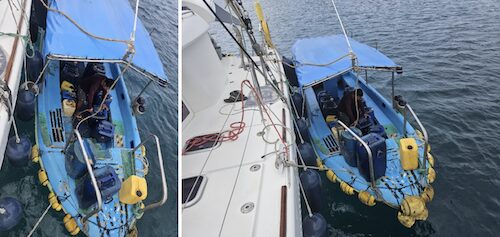

Fuelling in Puerto Ayora in Santa Cruz:
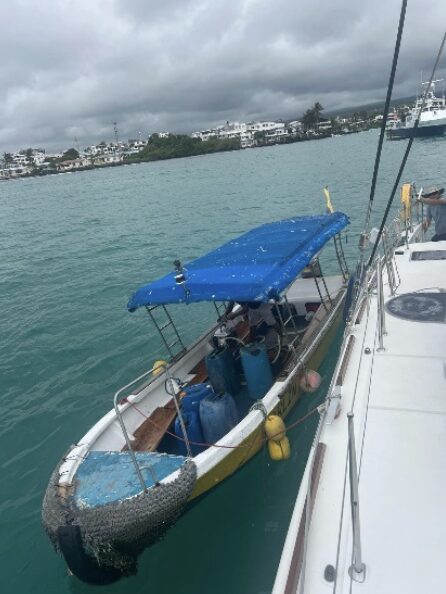

Checking out
You can check out from Santa Cruz, San Cristobel or Isabela. Although the latter is slightly closer to your next stop in French Polynesia, it also requires a $150 payment for an immigration official to travel over there from Santa Cruz. We checked out where we checked in which is Puerto Ayora in Santa Cruz. Check out involved giving at least 48 hours’ notice to our agents.
Our agent Danny met me on the quay at 10 am, took me with all the passports to immigration where they were stamped. After a quick shop for fresh bread, I returned to Hawkeye and the four officials arrived on board at 11am. The Armada inspected one of our cabins and opened some cupboards. They inspected a life jacket and checked that we had flares and a liferaft. Overall, it was a light inspection. We were given our Zarpe for the Marquesas and then allowed 30 minutes to pull up our anchor and start to leave Galapagos.
What did we learn?
Galapagos is pretty much on the way between Panama and French Polynesia so from a sailing perspective, unless you have a showstopper such as a dog or don’t have holding tanks, calling in there is a no-brainer.
Before arriving, its hard to see through the significant costs, bureaucracy and many restrictions such as not using our dinghy or going places without a guide.
However, the Galapagos is also known as the Enchanted Islands. Whether its swimming right next to sea lions, turtles and hammerhead sharks, all of whom show no fear of humans, or the quiet but welcoming people in their beautiful, well-equipped and crime free islands, or perhaps simply watching lots of baby black tip sharks swimming around your yacht, there certainly is an enchantment that is hard to describe.
Rather unexpectedly, our favourite turned out to be the sea lions, even though we’d seen them in zoos before, but in Galapagos they are wild and unafraid. They do have a significant body odour problem; frankly they stink! But their antics are endlessly amusing whether that’s on water or on land, with regular family disputes being played out in a friendly manner on the beach and in the sea. If you are as lucky as we were to engage and swim with them, which is entirely their choice, with their deep brown beguiling eyes gazing back straight at you as they clearly wonder how you could possibly be such a crap swimmer, it is an unforgettable moment.
In my view, if you can afford the time and the money, you should visit these islands, which certainly are enchanted. If you do visit then I’m sure you will enjoy Galapagos and, on reflection, decide that it was absolutely worth the cost and effort; we did!
Richard Freeborn
SV Yacht Hawkeye
February 2024
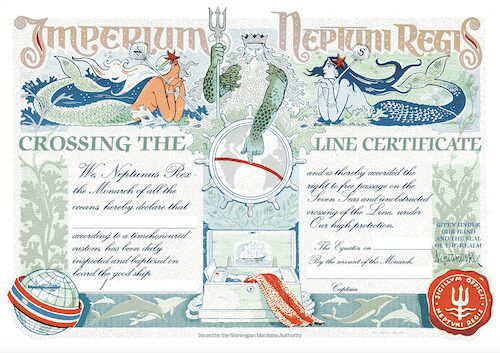

…………………………………
The opinions expressed in this article are the author’s own and do not reflect the view of Noonsite.com or World Cruising.
…………………………………
Find out all news, reports, links and comments posted on Noonsite, plus cruising information from around the world, by subscribing to our FREE monthly newsletter. Go to https://www.noonsite.com/newsletter/.
Related to following destinations: Floreana, Galapagos, Isabela, Outer Islands (Galapagos), Puerto Ayora (Academy Bay), Puerto Baquerizo Moreno (Wreck Bay), Puerto Villamil, San Cristobal, Santa Cruz
Related to the following Cruising Resources: Circumnavigation, Circumnavigation, Pacific Crossing, Routing




